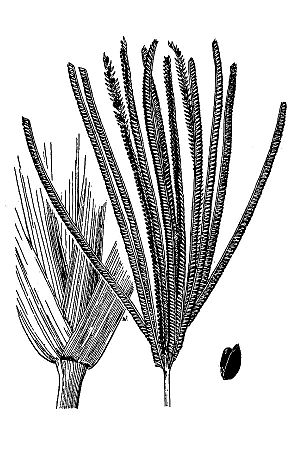Saltmarsh fingergrass facts for kids
Quick facts for kids Saltmarsh fingergrass |
|
|---|---|
 |
|
| Conservation status | |
| Scientific classification | |
| Genus: |
Eustachys
|
| Species: |
glauca
|
The saltmarsh fingergrass, also known by its scientific name Eustachys glauca, is a special type of grass. It grows naturally in the southeastern parts of the United States. This grass is known for living for many years, unlike some plants that only live for one season.
Contents
What is Saltmarsh Fingergrass?
Saltmarsh fingergrass is a plant that can grow quite tall, reaching up to 4 feet (about 1.2 meters) high. It has long, dark green leaves that are often folded. These leaves can be 12 to 14 inches (about 30 to 35 centimeters) long and have rounded tips.
How Does it Look?
At the base of each leaf, there's a tiny fringe of hairs called a ligule. This is a small part of the plant that helps protect the stem. The plant's seedhead, which holds its seeds, looks like a cluster of long spikes. There are usually 15 to 20 of these spikes, and each one can be up to 5 centimeters long. Along one side of each spike, you'll find small, brown parts called spikelets. These spikelets are where the seeds are formed.
Where Does it Grow?
This grass loves to grow in places near the coast. You can often find it in marsh lands, which are wet, grassy areas, and in sloughs, which are muddy channels or swamps. It especially likes soils that are "calcareous." This means the soil has a lot of calcium carbonate, like limestone.
Why is it Important?
Saltmarsh fingergrass is a good source of food for livestock, such as cows and other farm animals, that graze in these areas. They can eat this grass to get the nutrients they need. However, it's important not to let too many animals eat the grass in one spot for too long. If animals eat too much of it, this is called overgrazing, and it can actually kill the grass. This is why managing grazing areas carefully is important to keep the grass healthy.
Life Cycle and Reproduction
This grass is known for growing for a long time during the year. It can even produce seeds more than once in a single season. This helps the grass spread and grow in new places, making sure there's always plenty of it in its natural habitat.


